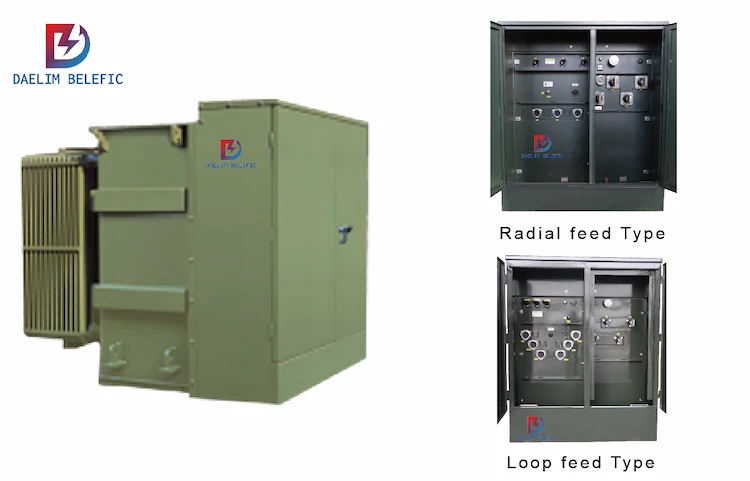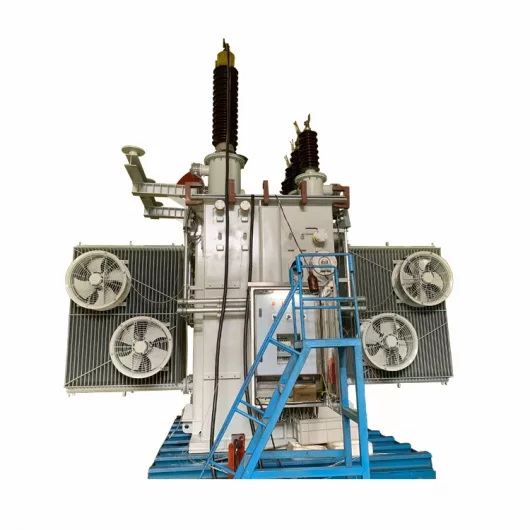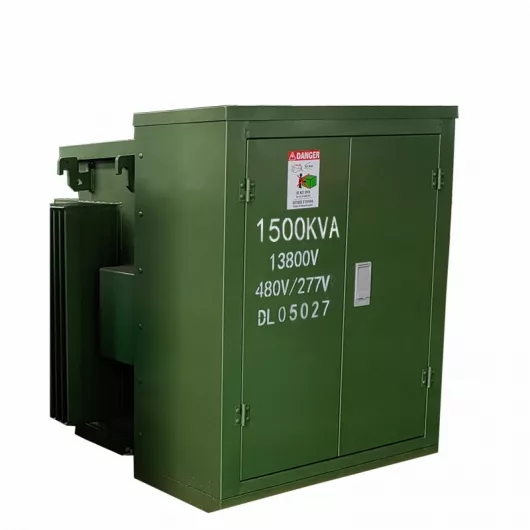ELECTRIC, WITH AN EDGE
2000 kva three phase pad mounted transformer is a complete set of transformer and distribution equipment that combines combined transformer, load switch and protective fuse device of high-voltage power receiving part, metering and switch of low-voltage power distribution part. Technology, a new type of complete set of transformer and distribution equipment developed in combination with actual conditions.
Because the 2000 kva three phase pad mounted transformer has the characteristics of small size, low investment, convenient operation, fast installation, simple maintenance, etc., it is widely used in power distribution systems, especially in the construction and transformation of urban and rural power grids, and is widely used in industrial parks. , Residential quarters, commercial centers and high-rise buildings and other occasions.
The structure is compact and reasonable, and the volume is small, which is only about one-third of the European-style box change of the same capacity;
Fully sealed and fully insulated structure, no safety barrier is required, and personal safety is guaranteed;
There are a variety of power supply schemes for users to choose from, which can adopt terminal power supply and realize ring network or dual power supply;
S11 oil-immersed power transformer is adopted, which has low loss, low temperature rise and strong overload capacity;
Double fuses (backup protection fuse + plug-in fuse) are used for protection, and the plug-in fuse fuse has the characteristics of current and temperature dual sensitivity to ensure the safe and reliable operation of the product;
The 200A cable connector can be plugged and unplugged under load, and can be operated as a load switch in an emergency. It also has the characteristics of an isolating switch.
The winding adopts Dyn11 connection and the iron core adopts a three-phase four-column structure, so that the product can run under any asymmetric load, and the neutral point does not drift, the voltage is stable, the power supply quality is high, the cabinet heats up, the noise is low, and the lightning protection performance is good ;
The cabinet adopts anti-corrosion design and special spray paint treatment, beautiful and novel, suitable for various environments, and achieve the effect of beautifying the city.

The 2000 kva three phase pad mounted transformer is divided into a transformer part and a control cabinet part.
The transformer part is a fully sealed structure, and the insulating oil can be high ignition point oil or ordinary oil.
The control cabinet is divided into a high-voltage room and a low-voltage room.
The high-voltage room is installed with: high-voltage cable plug, lightning arrester, load switch operating handle, non-excitation tap switch handle, plug-in fuse, pressure release valve, thermometer, pressure gauge, oil Position indicator, oil filling plug, oil drain valve, etc., load switch, non-excitation tap changer, plug-in fuse, etc. are all immersed in transformer oil together with the transformer core.
The high-voltage cable and the transformer are connected by elbow cable connectors.
The low-voltage side can be installed with air circuit breakers, current transformers, as well as electric energy meters, ammeters and voltmeters, and output circuits and capacitance compensation devices can be configured according to user needs.
| No. | Item | Unit | Data | |
| 1 | Rated voltage | Primary side | kV | 10 |
| Secondary side | kV | 0.4 | ||
| 2 | Rated capacity | kva | 100~800 | |
| 3 | No-load voltage regulation | ±2×2.5% | ||
| 4 | Connection method | D.yn11 | ||
| 5 | Rated insulation level | High voltage side lightning impulse withstand voltage | KV | 75 |
| High-voltage side power frequency withstand voltage 1min | KV | 35 | ||
| Low-voltage side power frequency withstand voltage 1min | KV | 2.5 | ||
| Control and metering loop 1min | KV | 2 | ||
| 6 | noise level | ≤45 | ||
| 7 | Protection level | IP34 | ||
| 8 | Cooling method | Oil-immersed self-cooling | ||
2000 kva three phase pad mounted transformer is a complete set of transformer and distribution equipment that combines combined transformer, load switch and protective fuse device of high-voltage power receiving part, metering and switch of low-voltage power distribution part. Technology, a new type of complete set of transformer and distribution equipment developed in combination with actual conditions.
Because the 2000 kva three phase pad mounted transformer has the characteristics of small size, low investment, convenient operation, fast installation, simple maintenance, etc., it is widely used in power distribution systems, especially in the construction and transformation of urban and rural power grids, and is widely used in industrial parks. , Residential quarters, commercial centers and high-rise buildings and other occasions.
The 2000 kva three phase pad mounted transformer adopts a number of scientific research results such as a new type of insulation structure and a structure to improve the ability of short-circuit resistance.
Using new technology, high-quality materials, advanced equipment, and other means, its performance has reached the international advanced level.
Compared with the S7 series, the no-load loss is reduced by an average of 10.25%, the no-load current is reduced by 37.9%, and the load loss is reduced by an average of 22.4%.
The iron core is a fully inclined three-stage joint laminated structure, and the no-load loss and no-load current are lower than the old products;
The high and low voltage windings are all wound with oxygen-free copper wire, the high voltage winding adopts a multilayer cylindrical structure, and the low voltage winding adopts a cylindrical structure and an improved spiral structure;
Using a new type of insulation structure, strong short-circuit resistance;
Use new components and fasteners
According to the specified capacity of power transformers above 1. 6MVA, the unbalance rate of phase resistance should not be greater than 2%, and the unbalance rate of line resistance should not be greater than 1% for windings without a neutral point; power with a capacity of 1.6MVA and below For transformers, the unbalance rate of phase resistance is generally not more than 4%, and the unbalance rate of line resistance is generally not more than 2%.
In engineering practice applications, generally for all three-phase transformers, regardless of their capacity, the limit of the unbalance rate of the DC line resistance is 2%.
It is the basic equipment for power transmission and distribution and is widely used in industry, agriculture, transportation, urban communities and other fields. Transformer oil leakage is the most common fault in the entire power transformer. It will cause subsequent problems, such as serious environmental pollution to the air, and may also cause a lot of waste of resources, which will greatly increase the operation of the enterprise. Costs in turn increase the economic pressure and market resistance of enterprises. As a hidden safety hazard, this problem will greatly affect the safe and stable operation of power transformers, and in severe cases, it may cause the inability of machinery and equipment to operate. It should also be noted that the failure will also have an impact on the service quality of power companies, and will have a major negative impact on the provision of safe and scientific services to customers who use electricity.
Transformer is one of the key electrical equipment in power distribution station. Transformer can solve the heat dissipation problem of large space heat pipe and the problem of high working voltage insulation layer and is widely used. However, the common problem of oil leakage in the operation of transformers seriously endangers the safe operation of the transformer. So can the oil leakage of the transformer still be used? How to deal with it? Let’s take a look.
Let’s first look at the consequences of transformer oil leakage:
1. Transformer oil leakage not only seriously affects the appearance, but also causes economic losses due to the need to shut down the transformer to eliminate leakage.
2. Oil leakage will seriously interfere with the operation and maintenance personnel’s monitoring and judgment of the sealing condition in the transformer oil conservator and the correctness of the oil level indicator.
3. After the oil level is lowered due to leakage, the live joints, switches, etc. may operate without oil insulation, which may cause breakdown, short circuit, burnout, and even equipment explosion.
4. After the transformer oil leaks, the fully sealed transformer will lose its sealing state, and the oil-paper insulation will easily suffer from the intrusion of external air and moisture, which will reduce the insulation performance, accelerate the aging of the insulation, and affect the safe and reliable operation of the transformer.
A power supply company’s transformer spool leaked oil. Most of the spool valve stem seal failures caused serious oil leakage.
Due to the special working environment of the transformer, it was not allowed to shut down for a long time, so it could not meet the needs of replacing new parts.
The use of Soleil carbon nano polymer material technology is currently a more effective way to solve transformer oil leakage.
Its main feature is that some leakage points can be managed without shutdown without any impact on the transformer casing itself and the transformer oil.
The 2000 kVA pad-mounted transformer is a robust and versatile piece of equipment, designed to handle substantial electrical loads with ease. Here’s a closer look at its key specifications and features:
The 2000 kVA pad-mounted transformer is a powerhouse, engineered for efficiency, safety, and versatility. Understanding these specifications is crucial for anyone involved in their selection, installation, or maintenance. With their robust design and advanced features, these transformers are well-equipped to meet the demands of modern electrical distribution needs.
Installing a 2000 kVA pad-mounted transformer is a critical task that requires meticulous planning and adherence to technical standards. This section aims to guide you through the essential aspects of installation, emphasizing the importance of power supply wiring diagrams.
The installation of a 2000 kVA pad-mounted transformer is a complex but manageable task when approached with the right knowledge and tools. Detailed wiring diagrams, adherence to safety standards, and careful planning are the keystones to a successful installation. Always remember, the safety and efficiency of the transformer depend significantly on the precision and quality of its installation.
When considering the purchase of a 2000 kVA pad-mounted transformer, understanding its pricing is essential. This section aims to provide a more detailed analysis of the factors that influence cost, offering practical insights for potential buyers.
Understanding the nuanced pricing of 2000 kVA pad-mounted transformers is key to making an informed purchase decision. By considering detailed factors such as material quality, cooling systems, energy efficiency, and customization, buyers can better gauge the true value and long-term benefits of their investment.
The 2000 kVA pad-mounted transformer is a powerful unit designed for robust performance. This section delves into its operational parameters and capacity, providing practical insights for users to understand its capabilities and limitations.
Understanding the operational parameters and capacity of a 2000 kVA pad-mounted transformer is crucial for efficient and safe usage. Accurate calculations and considerations of practical aspects like cable sizing, load distribution, and power consumption are key to harnessing its full potential.
The capacity of the transformer is expressed by the apparent power unit kVA (kilovolt-ampere) to illustrate the size of the transformer output capacity.
Various loads, such as motors, are expressed in active power kW (kilowatts) to illustrate the size of their output power.
In addition to converting electrical power into mechanical power, the motor also needs a certain amount of reactive power during operation.
Therefore, the transformer must provide active power to the motor as well as reactive power.
Active power refers to the power that converts electrical energy into mechanical energy, heat energy, light energy, etc., which is the energy actually consumed;
While reactive power only forms a magnetic field in the motor, allowing the motor to run and perform external work, because the principle of the motor is The energized conductor is subjected to force in the magnetic field, but this part of the power that forms the magnetic field does not actually consume energy and does no external work, so it is called reactive power.




After filling in the contact information, you can download the PDF.